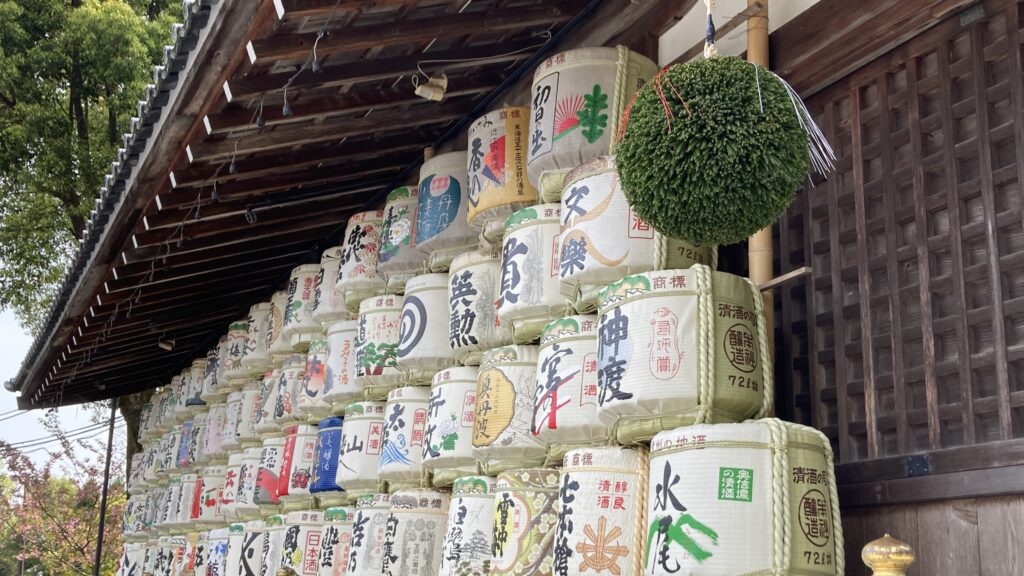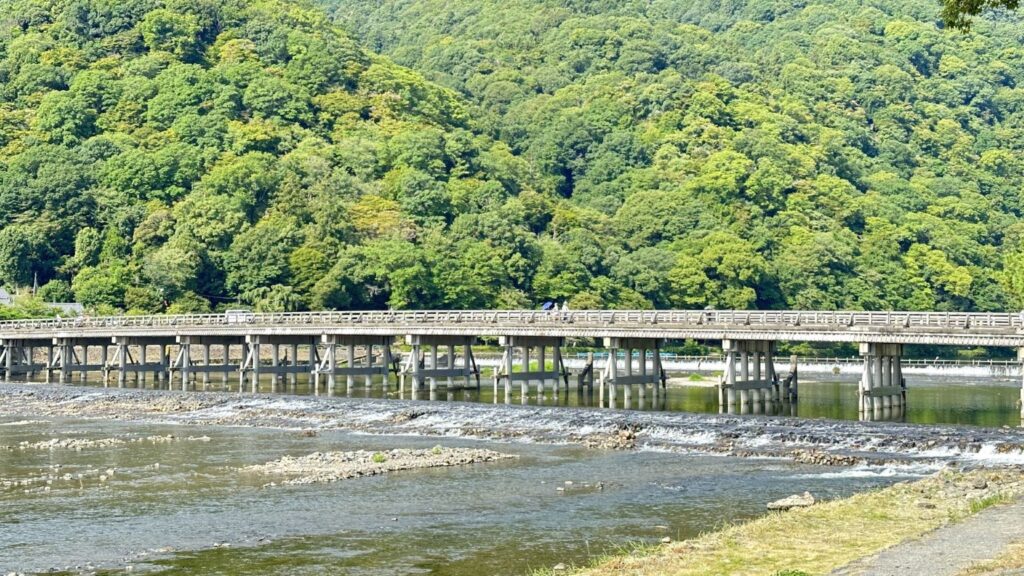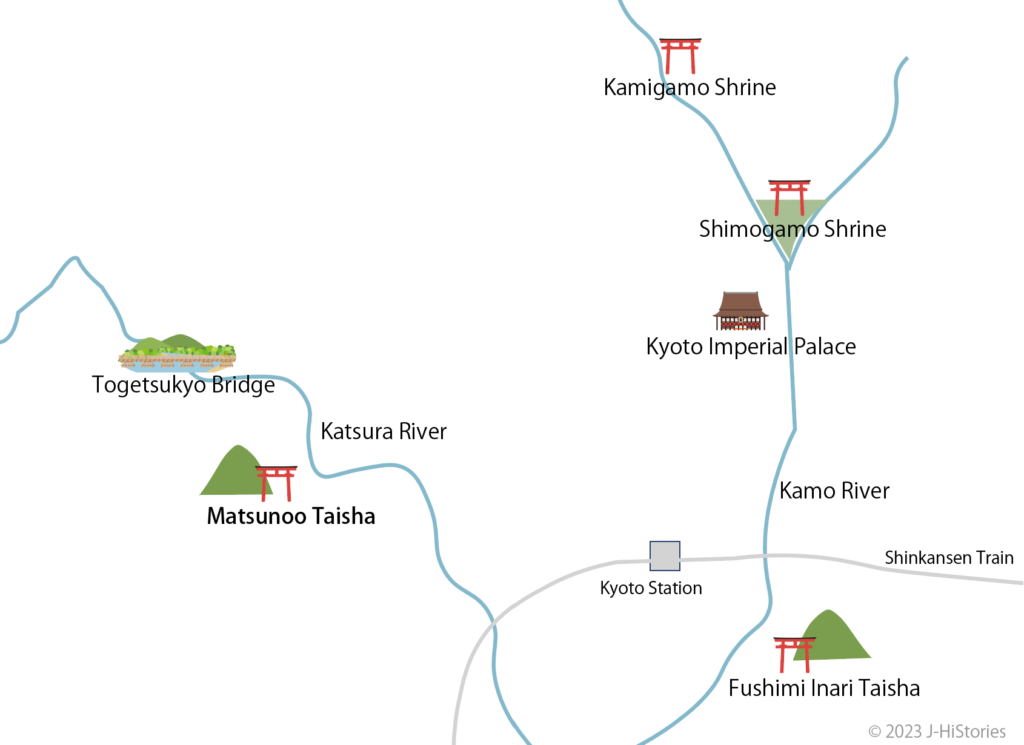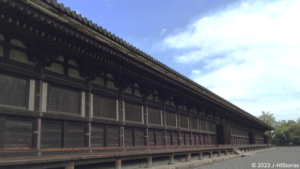Unveiling the Secrets of Matsunoo Taisha, the Best Sake Brewery Shrine
Matsunoo Taisha Shrine stands as one of Japan’s revered three sake shrines, alongside Omiwa Jinja, and Umemiya Jinja, all venerating the sake deity worshipped by sake brewers. Upon crossing the Romon Gate, you gaze at the Shinyoko on the left, a warehouse for portable shrines. Here, a mesmerizing array of a variety of Komodaru straw barrels, offerings from sake brewers nationwide, stands in formation. Each barrel is bedecked with distinct, captivating adornments, inviting you to discover your personal favorite among them. On the right side of these barrels, a grand cedar ball hangs prominently. Over time, this new cedar ball gradually transforms from its initial dark green hue into a rich, deep brown, a visual testament to the maturation of sake. But why do sake brewers direct their prayers towards the Matsunoo Taisha deity? The answer lies in the presence of Mount Matsunoo, endowed with bounteous spring waters, and the Hata clan, renowned for their mastery in sake brewing.

Japan's Best Sake Brewing Deity

Since around the Muromachi period (1333-1573), Matsunoo Taisha has held the esteemed title of "Japan’s paramount sake brewing deity," commanding reverence from sake brewers across the nation. The pristine waters originating from the sacred Mount Matsuo have flowed steadfastly. Of particular note is the "Kamenoi," a hallowed spring that ceaselessly gushes forth in front of the waterfall, renowned for its ability to prevent sake from being spoiled during the brewing process. Even today, sake craftsmen make pilgrimages to Matsunoo Taisha in pursuit of this invaluable water source. As the autumn season ushers in the ripening of new rice and the art of sake brewing starts, the Jou-U-sai Festival, held in November, is to pray for a safe and prosperous brewing process. Following this, in the ensuing April, the Chu-U-sai Festival is held to express gratitude to the deities for the blessings bestowed upon the sake brewery.
The Hata clan, pioneers of farmland irrigation and the encouragement of new industries
The Hata clan, renowned for their proficiency in various domains such as civil engineering, flood control, mining development, sericulture, textiles, and even sake brewing, left an indelible mark on the region around the 5th century. They carried out large-scale flood control work on the Katsura River, known as a raging river flowing near Matsunoo Taisha, building a substantial weir on the northern side of the Togetsukyo Bridge and drawing in water from the Katsura River. They also brought in new techniques for sericulture and weaving and settled in the area. The remains of the weir are still visible from the Togetsukyo Bridge, a feat that harnessed the waters of the Katsura River. Residents who have been farming in this area since ancient times reaped the bountiful benefits of this sophisticated irrigation system.

At that time, the three states of the Korean peninsula (Koguryo, Silla, and Baekje) were in the midst of a relentless power struggle for supremacy, each vying with the others. Meanwhile, the Asian continent experienced a tumultuous period, commencing with the fall of the Later Han Dynasty in the 3rd century and culminating in the unification of the Sui Dynasty in the 6th century. Amidst the upheaval, it is said that the Hata clan refuged to Japan. Leveraging their advanced technological prowess, they played an instrumental role in pivotal projects, such as the excavation of the Naniwa Horie (a moat facing Osaka Bay) and the construction of the Manda Levee along a tributary of the Yodo River during the reigns of Emperors Ojin and Nintoku, among others. This left a remarkable mark on Japan’s history.
Guardians of Kyoto's Oldest Shrine: The Mountain God, The Sea God, and The Ferocious Spirit

In 701, the Matsunoo Taisha was built to enshrine two revered deities: the "Mountain God," Oyamagui-no-Kami, a deity worshipped near the top of Mt. Matsuo since the ancient period, and the "Sea God," Ichikishimahime-no-Mikoto, guardian of Genkai Sea, situated between the Korean Peninsula and Kyushu. This sacred Matsunoo Taisha is the oldest shrine in Kyoto. In subsequent years, during Emperor Kanmu’s relocation of the capital from Nara to Kyoto in 794, the Katsura River, which flows near Matsunoo Taisha, became a crucial unloading base for lumber to build the Imperial Palace. The skilled civil engineers of the Hata clan played a pivotal role in the construction of the capital and in supporting Emperor Kanmu’s reign. Consequently, the Matsunoo's deity became revered as a Ferocious Spirit, entrusted with safeguarding the capital, emperors, and the Imperial Palace.
Ancient Kyoto Shrines United by Aoi, Katsura, and the Hata Clan

The Katsura and Kamo Rivers are the two major rivers flowing through Kyoto. Matsunoo Taisha Shrine stands along the Katsura River, while Fushimi Inari Taisha Shrine resides downstream along the Kamo River. Further upstream, you’ll discover the Kamigamo and Shimogamo shrines. What unites these sacred three shrines is their unique connection to water sources, nestled amidst places blessed with natural springs. Behind Fushimi Inari Taisha, the holy waters flow from Mt. Inari. In ancient times, the Hata clan and other communities seemed to have chosen to settle in these lush, riverside areas, well-suited to live. In May, these shrines come alive with vibrant festivals. The Matsunoo Festival at Matsunoo Taisha, the Aoi Festival celebrated at Kamigamo and Shimogamo Shrines, and the Inari Festival at Fushimi Inari Taisha, these three festivals share a common tradition – dedicating hollyhock leaves and laurel sticks to their deities. The crests of Matsunoo Taisha and Kamigamo & Shimogamo Shrines are the Futaba-Aoi, the double-leaf hollyhock. It’s worth noting that Fushimi Inari Taisha Shrine is also believed to have its roots in the Hata clan. The Kyoto landscape, intricately woven by the Hata clan, is interwoven with the themes of sacred water, hollyhocks, and industrial progress.

The Hata clan played a pivotal role in Japan's nation-building, showcasing their engineering prowess and contributing significantly to various aspects, including the art of sake brewing. Join us on a journey to Matsunoo Taisha Shrine, situated near the enchanting Arashiyama in Kyoto. Here, you can savor Kyoto's finest sake. Additionally, we highly recommend exploring Fushimi Inari Taisha Shrine and Koryuji Temple, both steeped in the rich history and heritage of the Hata clan.
- Interviewed Shindo Keitaro (Shinto Priest of Matsunoo Taisha)
Hata Clan Timeline
| 3C | The initial Hata clan migrated to Japan | Kofun Period |
| 475 | Baekje fell in 475 | |
| 5C | Emperor Nintoku dug out a canal between Osaka Bay and Kawachi Lagoon | |
| 5C | Hata Clan carried out flood control work on the Katsura River | |
| 6C | Hata Kawakatsu serverd Prince Umayado | Asuka Period |
| 701 | Establishment of Matsunoo Taisha Shrine | |
| 711 | Establishment of Fushimi Inari-Taisha Shrine | Nara Period |
| 794 | The relocation of the capital to the city to Heian-kyo in Kyoto | Heian Period |
Recommendations to visit
- Access: 40 minutes from Kyoto Station. Take bus #28 bound for "Arashiyama Daikakuji (嵐山大覚寺)” at C6. Get off at "Matsunoo Taisha-mae (松尾大社前)" bus stop. Or a 2-minute train from Hankyu Arashiyama Station bound for Katsura. Get off at "Matsunoo Taisha (松尾大社)"


